Living Together with Japanese Language <4>
Toward Japanese for Mutual Understanding:
Focusing on the JF Standard for Japanese-Language Education
January 27, 2023
[Special Feature 077]
Shinozaki Setsuko
(Chief Lecturer at the Japan Foundation Japanese-Language Institute, Urawa)
Special Feature: "Living Together with Japanese Language" (for more on special features, click
here)
1. The Japan Foundation's Japanese-Language Programs and the JF Standard for Japanese-Language Education
Since its founding in 1972, the Japan Foundation ("JF") has long been involved in programs to support Japanese-language education overseas. The Foundation initially focused on training those researching Japan in order to promote understanding of the country. However, as Japan's international influence has grown, the purposes of studying the Japanese language have diversified. These include the acquisition of advanced technology, an increase in the number of people wishing to visit Japan, the introduction of Japanese as a foreign-language subject in local public education, and public interest in pop culture. As a result, there has been a demand for programs that meet the local needs of the time.
With such diversification of Japanese-language education overseas and a dramatic increase in the number of people learning Japanese, the JF Standard for Japanese-Language Education (the "JF Standard") was published in 2010 as a framework for considering methods of teaching, learning, and assessing Japanese while keeping an eye on trends in language education around the world. Since then, JF has developed Japanese-language programs based on the JF Standard mainly for countries overseas, but in recent years, there have been more occasions than ever before to refer to and utilize this accumulated knowledge in Japan as well. In this article, I will provide an overview of JF's Japanese-language programs, centered on the JF Standard, and information I would like to share with those interested in Japanese-language education in Japan.
2. What is the JF Standard for Japanese-Language Education (the JF Standard)?
The JF Standard is a framework for Japanese-language education based on the principle of mutual understanding. It was one of the first standards to incorporate the Common European Framework of Reference for Languages: Learning, teaching, assessment (the "CEFR"). Like the CEFR, the JF Standard endorses language teaching and learning based on an action-oriented approach, emphasizing the cultivation of competence in accomplishing tasks (the ability to use language to complete specific tasks) and competence in intercultural understanding (the ability to understand and respect one's own and other people's cultures).
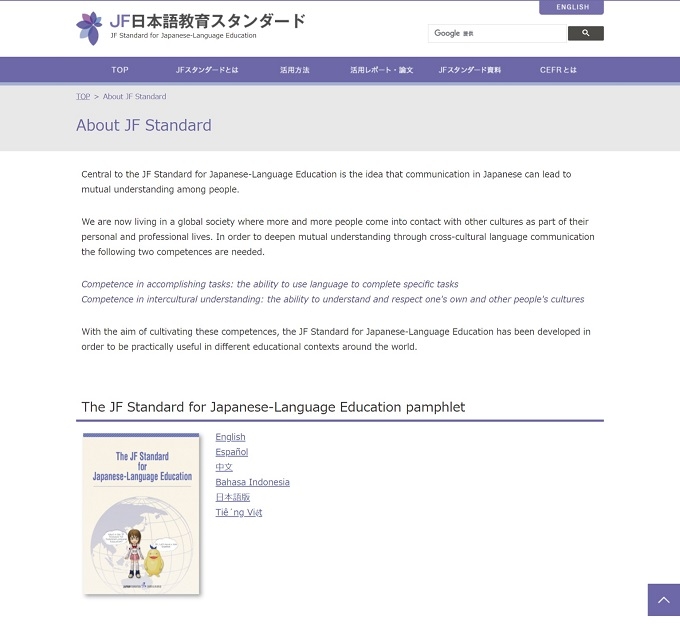 The JF Standard for Japanese-Language Education website
The JF Standard for Japanese-Language Education website
In Japanese-language education based on the JF Standard, the starting point is what you want to do using Japanese and what you want to be able to do. Suppose, for example, that you want to go out with your Japanese friends. In this case, the goal (task) is to invite friends somewhere in Japanese, and you learn the Japanese vocabulary, grammar, and expressions necessary to do so. This is the same as preparing the ingredients needed to cook a dish or the tools needed to climb a mountain. Ingredients differ depending on the dish, and the tools needed are different for climbing Mt. Fuji or Mt. Takao. Even in learning Japanese, it is important to think about what you want to do in Japanese and learn with that as your goal. However, the conventional approach in Japanese-language education has been to learn vocabulary and grammar in sequence for the time being, and then think about what can be done. This way of learning may increase your knowledge of the Japanese language, but it will not enable you to use Japanese in real-life situations.
In addition, similar to the CEFR, the JF Standard considers learning goals in terms of "Can-dos": "What can I do using Japanese?" It is then divided into the same six levels (A1-C2) as the CEFR. Therefore, no matter where in the world you go, you can explain your Japanese-language proficiency according to the CEFR levels. It is also possible to compare your Japanese level with your level in other foreign languages. For example, you can tell people, "My foreign-language proficiency is A2 in Japanese and B2 in English." With the JF Standard, JF aims to ensure that Japanese-language education institutions and teachers around the world discuss and exchange information using the same framework so that teachers and learners can share the same goals and continue learning more easily.
3. Japanese-language programs based on the JF Standard for Japanese-Language Education
The first thing JF set out to do after the publication of the JF Standard was to have people involved in Japanese-language education overseas understand the concept of the JF Standard, which referred to the CEFR. JF devised the "JF Standard tree" organizing and exemplifying language communication ability. They also introduced six levels of competence (A1-C2) in accomplishing tasks and, in addition, introduced Can-dos ("Can-do" statements).
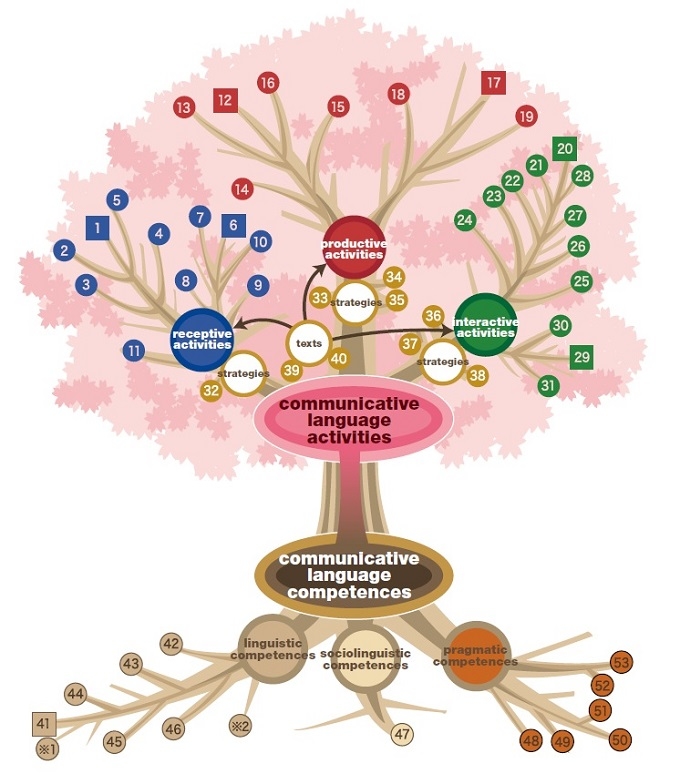 The JF Standard tree
The JF Standard tree Furthermore, JF places importance on lifelong learning and proposes the use of portfolios to document study as a way to support continuous learning. JF then advocated the use of the JF Standard to ensure consistent course design, from objectives to assessment. This content is widely available on the JF Standard website and in guidebooks. The Minna no "Can-do" website was released simultaneously to encourage actual use of Can-dos in educational settings.
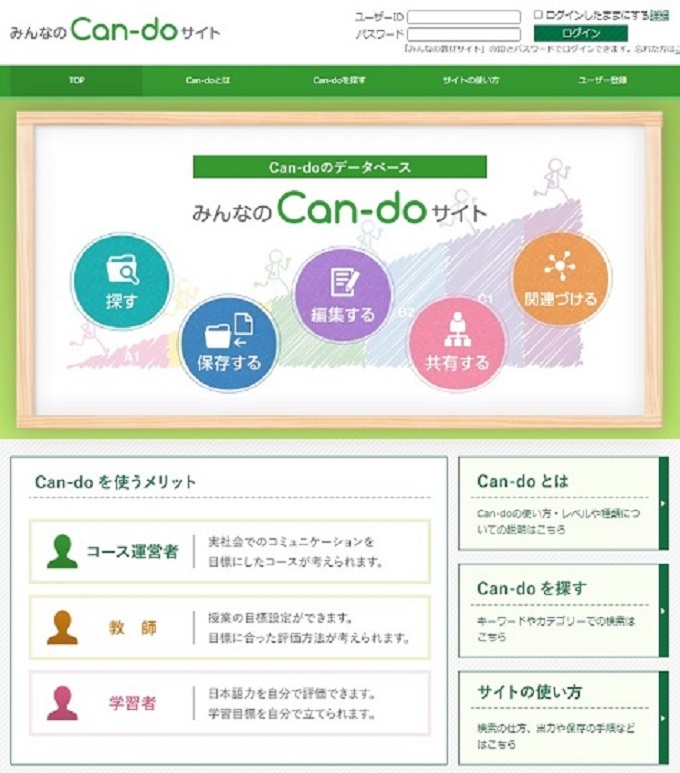 The Minna no "Can-do" website
The Minna no "Can-do" website
The second thing JF set out to do was to implement educational practices at its affiliated institutions in Japan, the Japanese-Language Institute, Urawa ("NC") and the Japanese-Language Institute, Kansai ("KC"), as well as at JF's overseas offices, and to develop teaching and learning materials conforming with the JF Standard. NC is mainly engaged in programs for overseas Japanese-language teacher training and the development of Japanese-language teaching and learning materials. They have been a key player in the development and dissemination of the JF Standard and were the first to introduce the JF Standard in teacher training and disseminate it to overseas Japanese-language teachers. KC mainly conducts training programs for Japanese-language learners such as specialized Japanese-language training and e-learning development programs, again based on the JF standard. JF's overseas offices and some other venues also offer a Japanese-Language Course for the general public (the JF language course), with 28 locations in 26 countries (as of 2021) providing education based on the JF Standard.
JF then developed and published the Marugoto: Japanese Language and Culture series ("Marugoto") in 2013 as learning materials to realize Japanese-language education based on the JF Standard. Marugoto learning materials were developed for adult learners from overseas and are designed to emphasize communication using Japanese, as well as understanding and respecting different cultures. The e-learning materials Marugoto + (Plus) and the Marugoto Japanese Online Course based on Marugoto have also been developed and released.
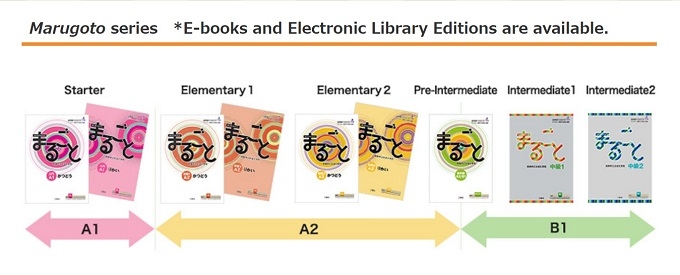 The Marugoto: Japanese Language and Culture series
The Marugoto: Japanese Language and Culture series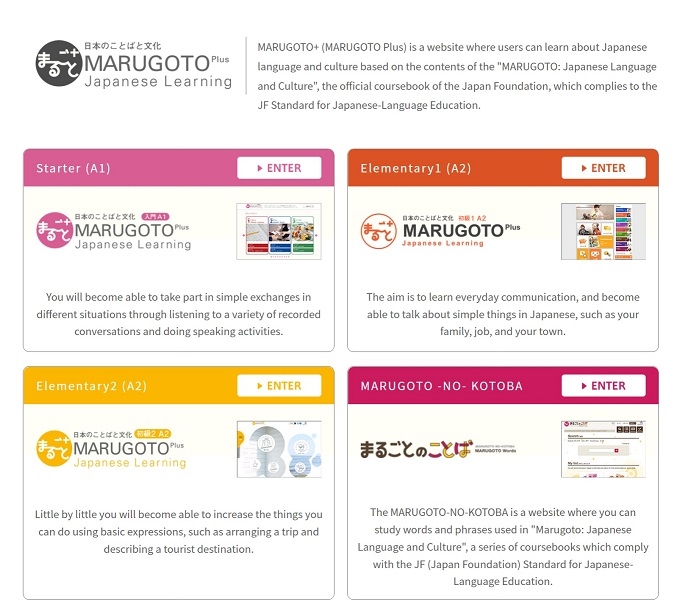 Marugoto + (Plus)
Marugoto + (Plus)JF Japanese e-Learning Minato also offers a variety of other courses based on the JF Standard.
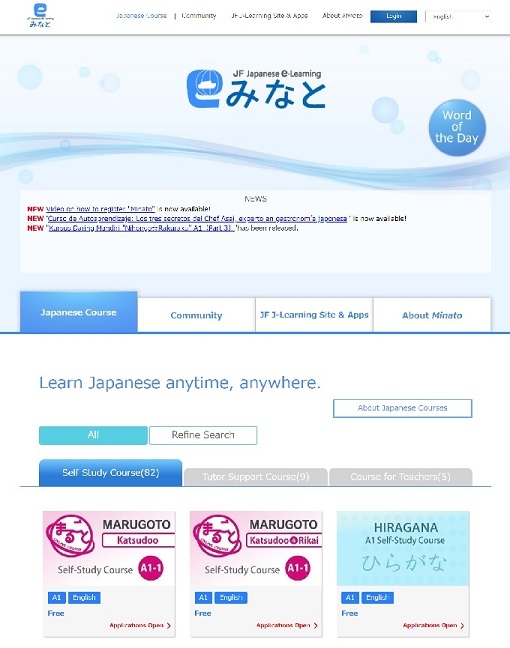 JF Japanese e-Learning Minato
JF Japanese e-Learning MinatoIn addition, new JF Standard-conforming teaching materials and lesson plans are available on the Minna no Kyozai website, which provides Japanese-language teachers with materials and ideas for their classes. Furthermore, JF has developed and released the role-play test based on the JF Standard as a conversation test founded on the JF Standard. These materials and resources are also widely used in conjunction with Marugoto.
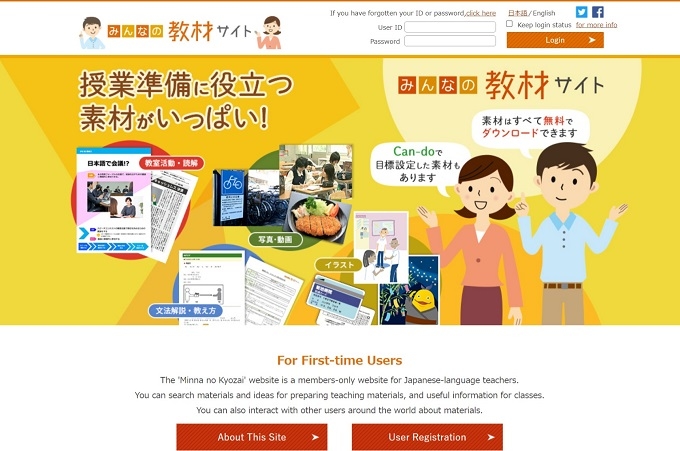
The Minna no Kyozai website (Teaching material website)
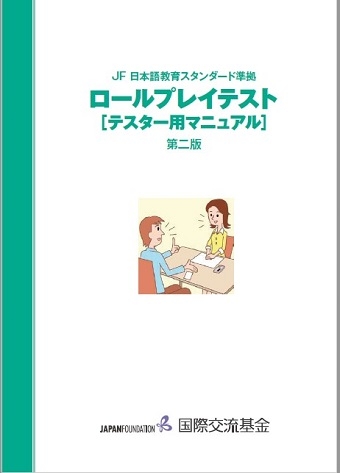 The role-play test based on the JF Standard
The role-play test based on the JF Standard
4. JF Japanese-language education based on the JF Standard for Japanese-Language Education: Japanese for everyday life and work
Since the publication of the JF Standard, JF has been working to permeate and improve the teaching environment in Japanese-language education overseas. JF has implemented Japanese-language programs for foreigners who are "specified skilled workers" based on the "Comprehensive Measures for Acceptance and Coexistence of Foreign Nationals" since 2019. Specifically, four projects are shown in the figure. Underlying these projects are JF's overseas Japanese-language programs and its experience in promoting the JF Standard.
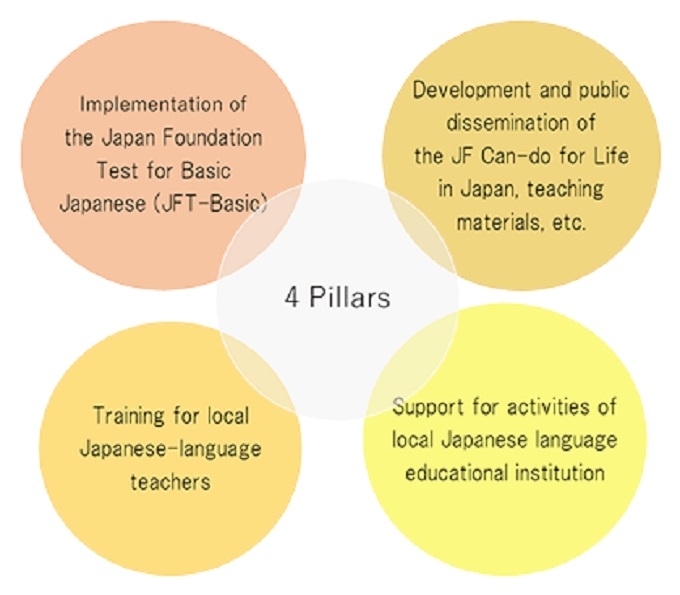 The four pillars of Japanese-language projects for foreign nationals with specified skills
The four pillars of Japanese-language projects for foreign nationals with specified skills The Japan Foundation Test for Basic Japanese (JFT-Basic) was developed with reference to the JF Standard to measure the Japanese-language proficiency needed by foreign nationals about to reside in Japan mainly for work, to communicate in everyday life situations. By March 2022, the program had been implemented in 10 foreign countries and in Japan.
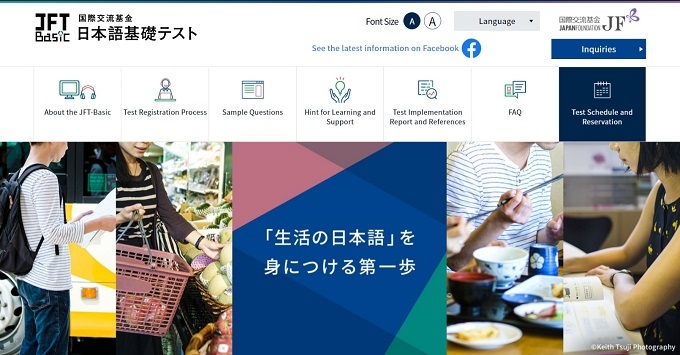 The Japan Foundation Test for Basic Japanese (JFT-Basic)
The Japan Foundation Test for Basic Japanese (JFT-Basic) "JF Can-do for Life in Japan" is a list of examples, in the form of Can-do statements, of fundamental Japanese communication skills required in everyday life and work situations in Japan for foreign nationals who are not native speakers of Japanese. It has been developed based on the principles and concepts of the JF Standard. Based on this, the Irodori: Japanese for Life in Japan series of Japanese language coursebooks ("Irodori") was developed. Irodori was created based on the experience of developing Marugoto and is a learning material that allows learners to study practical Japanese through a variety of situations and topics closely related to life in Japan. The fact that all materials are provided free of charge on the website is groundbreaking. Because they are based on life in Japan, the materials are increasingly being used not only for preparation before coming to Japan, but also after. The Irodori Japanese Online Course based on Irodori is also offered free of charge, creating an environment where learners can study Japanese on their own anytime, anywhere.
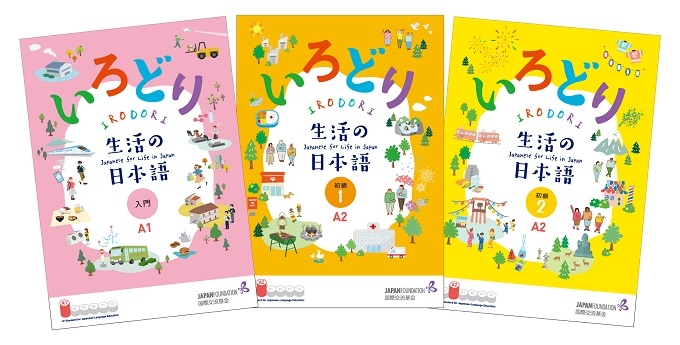 The Irodori: Japanese for Life in Japan series
The Irodori: Japanese for Life in Japan series 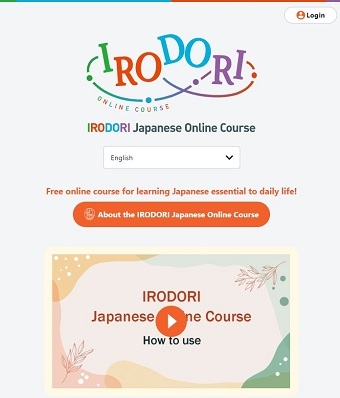 The Irodori Japanese Online Course
The Irodori Japanese Online Course
Moreover, the television program "ひきだすにほんご Activate Your Japanese!," produced by JF in collaboration with NHK Educational Corporation, began foreign broadcasts and video streaming in February 2022. This program introduces Japanese language and Japanese society and culture mainly to foreign citizens seeking to live and work in Japan and Japanese-language learners who wish to learn about life in Japan. It is produced with a focus on the strategies of the JF Standard.
JF has also provided specialized Japanese-language training for many years for foreign diplomats, civil servants, and researchers who need Japanese language skills for their work or research, and has created the Japanese-language learning website Nihongo de Care-Navi to support people engaged in nursing and caregiving. JF has also been involved in the EPA (Economic Partnership Agreement) Japanese-language Pre-training program for prospective Indonesian and Filipino nurses and care workers who wish to come to Japan. This accumulated experience of Japanese-language education for specific purposes has also been utilized in recent years in Japanese-language programs for foreign laborers.
5. For the future
As mentioned above, the results of the Japanese-language projects, especially the JF Standard, that JF has conducted for countries overseas are now being used in Japan as well. This is due in part to the fact that the spread of the internet has lowered the barriers between Japan and other countries. And there has been an even more significant development in Japan recently. In October 2021, the Agency for Cultural Affairs released the "Framework of Reference for Japanese-Language Education (Report)" (the "Framework of Reference") after consideration at the Japanese Language Subcommittee of the Council for Cultural Affairs. Since the Framework of Reference is based on the CEFR as well as the JF Standard, the ideas, teaching and learning materials, and teaching methods of the JF Standard that JF has developed over the years can be utilized when conducting Japanese-language education based on the Framework of Reference in the future (click here for more information on the relationship between the Framework of Reference and the JF Standard (only available in Japanese)).
Today, even more than in 2010 when JF published the JF Standard, the number of foreigners working in various fields in Japan is increasing year by year, as people migrate and come and go across borders. In the future, people of various nationalities and cultural backgrounds will have more and more opportunities to live in the same communities and work in the same workplaces. When trying to acquire the Japanese communication skills necessary for living and working in Japan, a learning and teaching method that takes as its starting point what one wants to do and be able to do using Japanese is likely to be more effective because the goals are clear and easily accepted. I hope that the accumulated experience of Japanese-language programs that JF has conducted over the years as part of its international cultural exchange programs will be utilized and referred to not only by people overseas, but also by those who study Japanese in Japan and those who are involved in Japanese-language education.
Shinozaki Setsuko
Chief Lecturer at the Japan Foundation Japanese-Language Institute, Urawa.
Ms. Shinozaki has been Lecturer since September 1992 and is primarily in charge of teacher-training programs at the Institute. She has been the Chief Lecturer since January 2021. As well as being dispatched to the Japan Foundation's overseas offices in Beijing (1999-2002), Paris (2013-2015), and Madrid (2018-2020) as a Japanese-Language Senior Specialists, she was involved in the revision of the Japanese Language Proficiency Test as a researcher at the Center for Japanese-Language Testing (2009-2012).
Related Articles
Keywords
Back Issues
- 2025.9.30 The 51st Japan Found…
- 2025.9.30 The Japan Foundation…
- 2025.9.30 Bringing the World C…
- 2025.9.30 The 51st (2024) Japa…
- 2025.9.30 Japan Foundation Pri…
- 2024.5.24 The 50th Japan Found…
- 2024.3. 4 Movie Theaters aroun…
- 2023.4.10 The 49th Japan Found…
- 2023.3.28 JF's Initiatives for…
- 2023.1.27 Living Together with…

